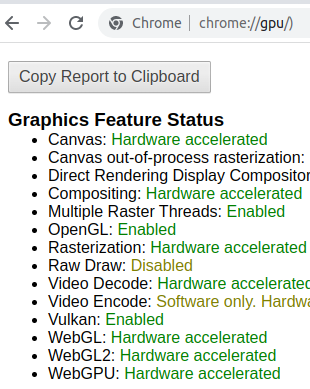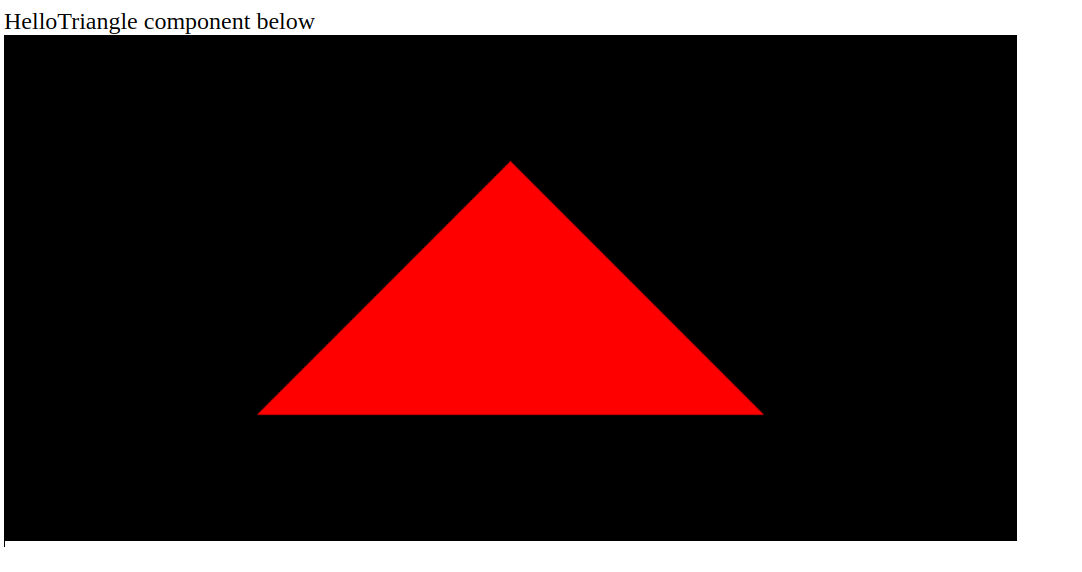nash1111 Tech Blog
Integrating WebGPU into Your Next.js and TypeScript Application Part 1
Goal
In this post, we will set up our development environment and draw a triangle using WebGPU, and then turn it into a component. We aim to render the red triangle seen in this link within Next.js. In other words, our goal is to port this code into a component.
Environment Setup
Access chrome://flags/ in your chrome browser and turn on
WebGPU.
Access chrome://gpu/ in your chrome browser and make sure
WebGPU is enabled.

Install an extension for WGSL.
https://marketplace.visualstudio.com/items?itemName=PolyMeilex.wgsl
Add the WebGPU type definitions to your project ( type repo )
yarn add @webgpu/types
Add to types.d.ts to treat wgsl files as strings.
declare module "*.wgsl" {
const shader: string;
export default shader;
}
Add to next.config.js.
webpack: (config, { webpack }) => {
config.module.rules.push({
test: /\.(png|jpe?g|gif|webm)$/i,
type: "asset/resource",
generator: {
filename: "static/[path][name].[hash][ext]",
},
});
config.module.rules.push({
test: /\.wgsl$/i,
use: "raw-loader",
});
config.plugins.push(
new webpack.DefinePlugin({
__SOURCE__: webpack.DefinePlugin.runtimeValue((v) => {
// Load the source file and set it as a global definition.
// This is useful for easily embedding a file's source into the page.
const source = fs.readFileSync(v.module.userRequest, "utf-8");
return JSON.stringify(source); // Strings need to be wrapped in quotes
}, []),
})
);
Implementation
The
original code
was largely left as is. However, since compilerOptions was set to strict: false
in the original code and true in my project, I added things like checking for
the existence of the canvas. components/FirstWebgpu.tsx eventually ended up
looking like this:
import React, { useState, useRef, useEffect } from "react";
import triangleVertWGSL from "../shaders/triangle.vert.wgsl";
import redFragWGSL from "../shaders/red.frag.wgsl";
const HelloTriangle: React.FC = () => {
const [pageState, setPageState] = useState({ active: true });
const canvasRef = useRef<HTMLCanvasElement | null>(null);
useEffect(() => {
const canvas = canvasRef.current;
const init = async () => {
const adapter = await navigator.gpu.requestAdapter();
const device = await adapter?.requestDevice();
if (!pageState.active) return;
if (!canvas) {
console.error("canvas not defined");
return;
}
const context = canvas.getContext("webgpu") as GPUCanvasContext;
const devicePixelRatio = window.devicePixelRatio || 1;
canvas.width = canvas.clientWidth * devicePixelRatio;
canvas.height = canvas.clientHeight * devicePixelRatio;
const presentationFormat = navigator.gpu.getPreferredCanvasFormat();
if (!device) {
console.error("Device is not available");
return;
}
context.configure({
device,
format: presentationFormat,
alphaMode: "premultiplied",
});
const pipeline = device.createRenderPipeline({
layout: "auto",
vertex: {
module: device.createShaderModule({
code: triangleVertWGSL,
}),
entryPoint: "main",
},
fragment: {
module: device.createShaderModule({
code: redFragWGSL,
}),
entryPoint: "main",
targets: [
{
format: presentationFormat,
},
],
},
primitive: {
topology: "triangle-list",
},
});
const frame = () => {
if (!pageState.active) return;
const commandEncoder = device.createCommandEncoder();
const textureView = context.getCurrentTexture().createView();
const renderPassDescriptor: GPURenderPassDescriptor = {
colorAttachments: [
{
view: textureView,
clearValue: { r: 0.0, g: 0.0, b: 0.0, a: 1.0 },
loadOp: "clear" as const,
storeOp: "store" as const,
},
],
};
const passEncoder =
commandEncoder.beginRenderPass(renderPassDescriptor);
passEncoder.setPipeline(pipeline);
passEncoder.draw(3, 1, 0, 0);
passEncoder.end();
device.queue.submit([commandEncoder.finish()]);
requestAnimationFrame(frame);
};
requestAnimationFrame(frame);
};
init();
}, [pageState.active]);
return <canvas ref={canvasRef} />;
};
export default HelloTriangle;
Result
You can see the triangle being drawn at this
link.
Note: Please turn on WebGPU. 
In the next post, I would like to implement features such as changing colors
over time.